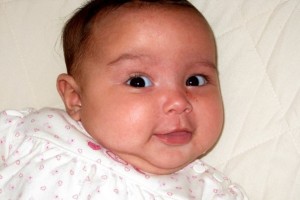We have been working on weaning Hannah off the Haldol for the past 10 days or so. We have no removed her afternoon and morning doses, as per the neuro’s schedule, and next Friday she will be completely off it. We have definitely noticed some effects so far, but are not sure if it is the lack of Haldol or the withdrawal from Haldol that is causing these issues.
She has been more, well, just not herself. Not really cranky as much as just not happy, I guess. Her sleep schedule is really messed up as well, as she is more restless than usual. Hopefully once the Haldol is completely out of her system, we can get an idea of how she really is doing.
We did our holiday photos tonight as well. It was a lot tougher than we had anticipated with Hannah. Even though she was willing and happy, it was hard keeping her movements under control enough to keep her seated long enough for me to take the many, many pics. Abby and Ethan were absolutely amazing with her and so patient. They helped by holding her hands and arms in a way that you think they are just being loving and not helping hold her steady.
One thing Daddy and I both noticed was that in all of Hannah’s pics, her eyes were mostly crossed (strabismus). I guess we don’t see as much in person, but when it is staring at you in multiple pictures, it feels like a knife through the heart. The most visible symptom of Gaucher’s disease type 2 — the fixed crossed eyes. Hannah does have it most of the time now. Sucks.
This on top of the news that Hannah’s soul sister, Olivia, and Addy are going through incredibly difficult times now. They both have Gaucher type 2. I mean, we aren’t talking just rough and inconvenient situations. Really, really tough and heartbreaking times. I find myself constantly thinking about them. It hurts, it really hurts and makes me very upset. Even Daddy has been feeling the stress of their situations, and it has affected him as well.
The thing is, when I think about Olivia and Addy and their situation, I always find myself putting ourselves in that situation as that could be us with Hannah at some point. Sooner than later, as we see how this disease is taking hold of her.
Daddy and I have had quite a few “reality check” conversations the past few days about Hannah’s condition. Conversations parents should not have to have about their toddler children. You know, in one respect, I feel very lucky that he and I can openly talk about what we are thinking and can share with each other, even when the conversations are ugly and scary. But I hate, hate, hate that we are having to have these conversations, the “what happens if? what do we do if? how do we handle blank if?”
And the worst question that kept pounding my brain — “What is next year’s family holiday picture going to look like?”



Latest Comments